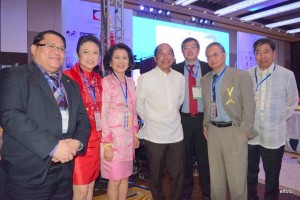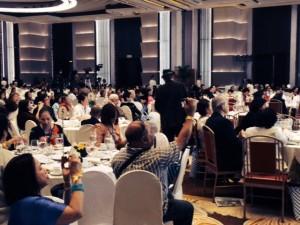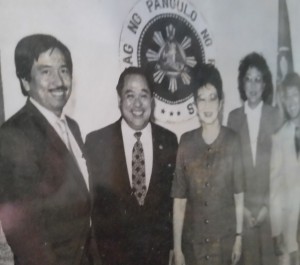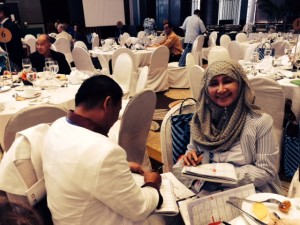Vision and action for the Filipino diaspora

INQUIRER.net columnist Rodel Rodis speaking at the 3rd Global Summit of Filipinos in the Diaspora February 25-27. CONTRIBUTED PHOTO
(Speech delivered at the opening plenary session of the 3rd Global Summit of Filipinos in the Diaspora held at the Manila Hotel, February 25-27, 2015).
The theme of this year’s Summit, “Vision and Action for the Filipino Diaspora 2015 and Beyond,” has the stated goal of “providing a venue for continued networking and convergence of the Filipino diaspora councils” in order to “craft a common vision and development action plan for the Filipino Diaspora communities for 2015 and beyond.”
We have convened our global Filipino Diaspora summits almost every other year since 2002 when we first came together at the Moscone Convention Center in San Francisco. Since then, we have met in Cebu, Honolulu, Sydney, Rome and, for the last five years, here in Manila. When we started, there were representatives from only a few countries. Today the 600 registered delegates gathered here represent more than 30 participating countries.

Global Summit leaders with CFO Chair Imelda Nicolas (second from left) and Budget Secretary Butch Abad (4th from left). CONTRIBUTED PHOTO
We are set to meet again in 2017 but the venue is not certain. Our last three global summits have been held in Manila sponsored by the Commission on Filipinos Overseas (CFO) under the inspired leadership of Secretary Imelda Nicolas who believes as we do that Filipinos abroad should be seen “not just as a remittance sender but more of an active participant in the Philippines socio-economic-political development”. Unfortunately, her CFO term coincides with that of Pres. Benigno S. Aquino III whose presidency ends on June 30, 2016. Thank you, Sec. Mely Nicolas and your CFO staff, for all your work to empower the Filipino diaspora.
Not our final global summit
A new president will be inducted into office on July 1, 2016 and he or she will then appoint a new head of the CFO. If the new president and the new CFO Secretary are opposed or indifferent to continuing support for the Filipino Diaspora, then this may be our last CFO-sponsored global summit. But it will not be the end of our biennial global summit of Filipinos. We will meet again in 2017 only perhaps not in Manila.
As we confront the prospect of where we will meet two years from now, let us look back at the Filipino diaspora and reflect on where we have been and why we need to continue to empower ourselves as a global Filipino diaspora movement.
Diaspora is generally used to describe historic mass dispersions of people with common roots. It has also been defined as a transnational community of people with a shared identity as a singular ethnic group created by a forced or induced historical emigration from an original homeland.
Prof. Jonathan Y. Okamura from the University of Hawaii views the global Filipino diaspora as an imagined community where Filipinos, wherever they may be in the world, “are aware of one another’s presence and of the bonds of culture, national identity, custom and tradition that they share.”
History of the Filipino diaspora
When Spain began its colonization of the Philippine Islands in 1565, it conscripted native Filipinos (Indios) to build Manila galleon ships that would ply the trade route from Manila to Acapulco and to also serve as sailors on those ships. Once in Acapulco, many of the Filipino mariners chose not to return to Manila but instead to work on other ships that traveled to Spain and other ports in Europe.
In an 1892 editorial in La Solidaridad published in Barcelona, Spain, Editor Graciano Lopez Jaena noted the large presence of Filipino mariner communities in cities throughout Europe and as well as in Philadelphia, New York and New Orleans in the U.S.
Filipinos who jumped ship in New Orleans set up Filipino settlements in the marshlands of Barataria Bay, Louisiana — pioneering the dried-shrimp industry in the US –that became the subject of Lafcadio Hearn’s 1883 article published in Harper’s Weekly entitled “The Mahogany-Colored Manilamen of Louisiana.”
After the Philippines was annexed by the U.S. in 1901, starting from 1906 through 1925, more than 125,000 Filipino workers were brought to the U.S. by the Hawaiian Sugar Planters Association to work on the sugar cane fields of Hawaii and then brought to the mainland to work on other crops in the farm valleys of the U.S.
After WW II, and through the ‘50s and ‘60s, tens of thousands of Filipinos were recruited to work on U.S. Navy ships as stewards. After the liberalization of U.S. immigration laws in 1965, at least 50,000 Filipino professionals and petitioned relatives of immigrants annually migrated to the U.S.
Much later, after martial law was declared in the Philippines in 1972, Filipinos were encouraged to work abroad, especially in the Middle East, in order to remit their salaries back to the Philippines to prop up the fragile economy. A new term entered the Philippine vocabulary –first, Overseas Contract Workers (OCWs) and then later, Overseas Filipino Workers (OFWs).
$26.93 billion annual remittance to PH
According to data released by the Bangko Sentral ng Pilipinas (BSP), personal remittances from overseas Filipinos in 2014 set an all-time high for the Philippines at $26.93 billion, breaking the previous record of $25.35 billion posted in 2013. December of 2014 set the record for the highest monthly OFW remittance at $2.6 billion.
Ricardo B. Ramos observed that “the Philippines is probably the only country in the world that has institutionalized the deployment of its people to work overseas, from professionals and skilled workers to domestic help” since 1995, sending more than one million Filipinos annually to work abroad.
Now with about 14 million Filipinos in the diaspora, the concept of the Filipino nation has changed. The old view that it refers exclusively only to those living within its land area boundaries is now obsolete. As former Chief Justice Artemio Panganiban noted, “interactive news websites, cable TV programs, social networks like Facebook and Twitter, cell phones, Skype, Magic Jack, e-mails, teleconferencing and other electronic wonders no longer require actual physical presence to acquire thorough knowledge of Philippine political life.”
Yes, overseas Filipinos know what is going in the Philippines but do Filipinos in the Philippines know or care about what is going on in the Filipino diaspora?
In a 2003 Supreme Court decision, Justice Antonio Carpio commented that overseas Filipinos “are modern-day heroes and saviors of the economy. Their blood, toil, tears and sweat have propped up the Philippine peso through all the recurring financial crises that have battered the nation.”
Not just remittance senders
That appears to be all that Filipinos in the Philippines know about Filipinos in the diaspora. We are “remittance senders,” “saviors of the Philippine economy.” But do they know or care that thousands of Filipino OFW women are routinely raped by their employers in the Middle East? Do they know or care that some Philippine diplomats, instead of protecting our OFWs, even prey on them and demand and extract sex in exchange for emergency housing and funds to return back to Manila?
Two months after Marcos was deposed by People Power in 1986, Pres. Cory Aquino invited anti-Marcos Filipinos in America to visit her in Malacanang to express her appreciation for what overseas Filipinos did to help restore democracy back to the Philippines.
In that meeting, she asked us what she could do for us. On behalf of our group, I told her that we only have two requests: her support for overseas Filipinos to have the right to vote in Philippine elections and her support for dual citizenship to allow overseas Filipinos who have become citizens of their host countries to reacquire or retain their Philippine citizenship.
I told Pres. Cory Aquino that suffrage for overseas Filipinos would allow us to have a voice in the good governance of the country, in the election of leaders whose decisions affect overseas Filipinos and their families in the Philippines. It woul dalso compel Philippine politicians to consider the needs and sentiments of overseas Filipino voters.
Suffrage for overseas fFlipinos
Pres. Aquino told us she would study dual citizenship, but she expressed enthusiastic support for suffrage for overseas Filipinos. A year later, in the 1987 Philippine Constitution, she included as Article V, Section 2 the provision that: “The Congress shall provide a system for securing the secrecy and sanctity of the ballot as well as a system for absentee voting by qualified Filipinos abroad.”
Despite her support, it would take another 16 years before the Overseas Absentee Voting Act would pass the Philippine Congress and be signed into law by Pres. Gloria Macapagal-Arroyo on February 13, 2003.
Unfortunately, that bill contained a “poison pill” that required absentee voters to sign an affidavit of intent to return to the Philippines within three years or face penalties of up to a year in jail, a provision that effectively killed any enthusiasm for overseas voting. It would take another decade of intense lobbying before this insane and onerous provision would be removed in an amended overseas voting bill that was signed into law by Pres. Benigno S. Aquino III on May 27, 2013.
But the damage was done. Because of this provision, which showed contempt for the “bagong bayani” (new heroes), only 850,000 overseas Filipinos have registered to vote and only a small fraction of that have actually voted.
An empowered Filipino diaspora
We had hoped that if at least five million overseas Filipinos registered and voted, we would represent a significant portion of the electorate and constitute a major good governance force in Philippine politics. But that has not happened. The only way we can reach that goal is if the Philippines provided for Internet voting for overseas Filipinos especially for the 500,000 Filipinos who work in cruise ships and maritime cargo vessels. Given how long it takes to get anything to pass the Philippine Congress, it is not likely Internet voting will be enacted in time for the 2016 elections.
That is our challenge: how to be a significant force in the 2016 presidential elections despite our low voting numbers. How do we leverage our almost $27 billion a year in remittances to the Philippines to influence Philippine voters to support candidates endorsed by and supportive of the interests of OFWs?
We should ask the candidates what they plan to do to safeguard and protect our OFWs. We should ask the presidential candidates if he or she intends to continue the CFO’s support for the Filipino diaspora and our biennial summits.
The India diaspora model
One day, if we work for it, the Philippine government will develop an enlightened view of the Filipino diaspora just as the Indian government has of its diaspora. In 2004 India established the Ministry of Overseas Indian Affairs (MOIA) to connect the Indian diaspora community with its motherland, viewing the 25 million Indians in the diaspora not just as “remittance senders” but as “an important ‘bridge’ to access knowledge, expertise, resources and markets for the development of the country of origin.”
“The success of this bridge is often predicated upon two conditions: the ability of the diaspora to develop and project a coherent, intrinsically motivated and progressive identity and the capacity of the home country to establish conditions and institutions for sustainable, symbiotic and mutually rewarding engagement. Home countries are now beginning to recognize the need to pursue and promote the dynamic of the diaspora and development.

More than 600 expatriates from all over the world came to the Summit. INQUIRER.net PHOTO
“India’s engagement with its diaspora is symbiotic, the strands of both sides of the relationship equally important to create a resilient and robust bond. To engage with the Diaspora in a sustainable and mutually rewarding manner across the economic, social and cultural space is at the heart of the policy of the Ministry.”
One day, there will be genuine overseas Filipino representatives in the Philippine Congress. One day, the Filipino diaspora will be seen by the Philippine government as an integral part of the Philippines and included in the programs of all the executive departments and not just of one governmental agency.
One day, our Global Summit of Filipinos in the Diaspora will have delegates from more than 100 countries and it will be attended by the president, cabinet members, senators, representatives all wanting to know what they can do to serve our needs.
That day will come, and it will come sooner than we think.
(Rodel Rodis is the President of the Global Filipino Diaspora Council (GFDC) which plans to organize Filipino Diaspora conferences and Diaspora councils in all the continents from Europe to the Middle East, Asia, Oceania, Africa and North America. Send comments to [email protected]).
RELATED STORY
Filipino expats from 30 countries meet in Manila

















